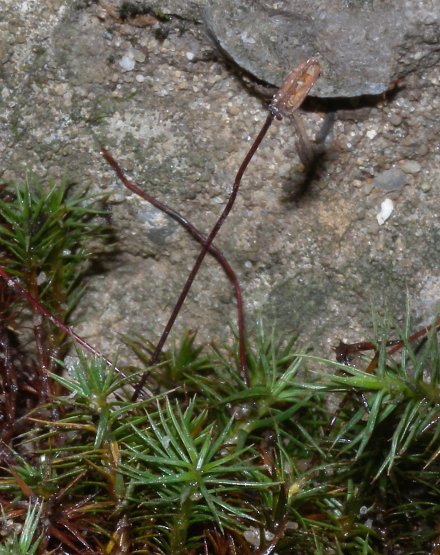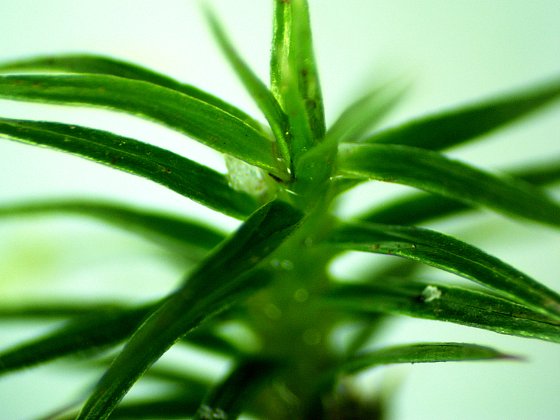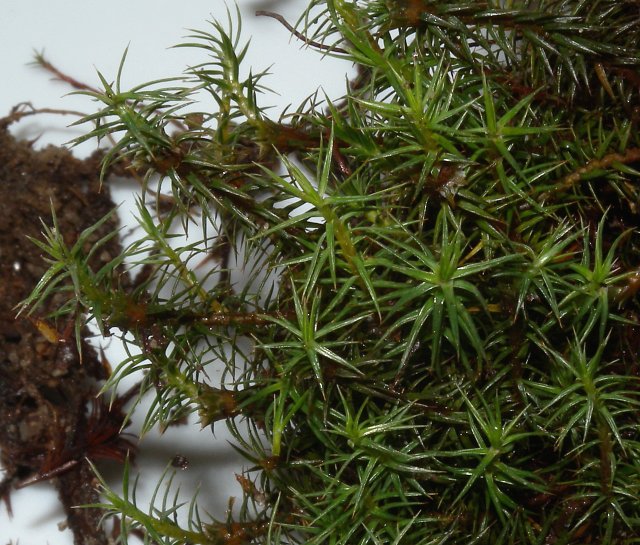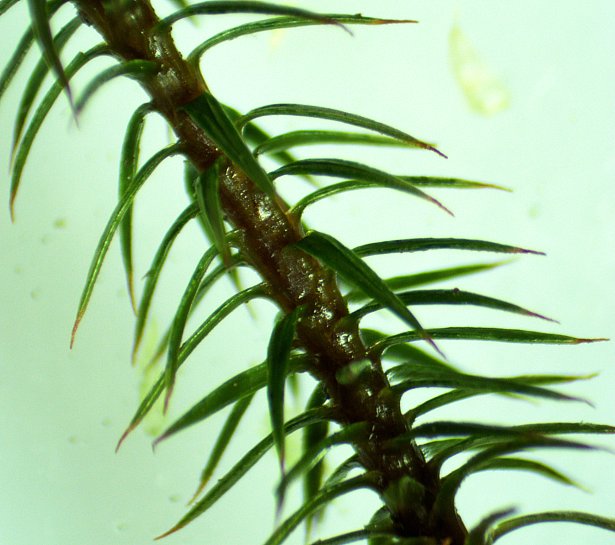
This moss is dioicous, forming male reproductive organs (antheridia) and female reproductive organs (archegonia) on separate plants at their apices. These reproductive organs are surrounded by shallow rosettes of modified leaves. The male reproductive organs, in particular, are yellowish orange to dark red; their sperm are spread to neighboring plants, in part, by raindrop logistics. After fertilization of the female reproductive organs occur, solitary sporophytes develop from the apices of fertile female plants. Each sporophyte consists of a slender seta (stalk) and a spore-bearing capsule. The setae are 2-6 cm. long, more or less erect, terete, and red to reddish brown at maturity. At the apices of the setae, are solitary spore-bearing capsules about 2.5–5 mm. long. Immature capsules are held erect, while mature capsules become tilted at an angle or they are held sideways. Immature capsules are covered by hairy-membranous hoods (calyptrae) that are beaked, although these hoods soon split apart and fall to the ground. While immature capsule bodies are light green and nearly terete, mature capsule bodies are brown and 4-angled, except at their bases, where they are more narrow and ring-shaped. The shallow lids of the capsule bodies taper abruptly to moderately short narrow beaks; these lids eventually fall off, revealing the circular mouths of the capsule bodies and their rings of 64 minute teeth. The mouths of the capsule bodies have flat circular plugs that also fall to the ground, releasing the tiny spores to the wind. These spores are 8-10 micrometers across, globoid in shape, and smooth. This moss anchors itself to the substrate with fibrous rhizoids at the stem bases. Decumbent lower stems on the ground are also able to form fibrous rhizoids, from which clonal plants can develop.

Cultivation: The preference is full sun to light shade, moist to dry conditions, and an acidic mineral soil containing gravel and/or sand. This moss also adapts to thin soil over rock and higher pH conditions. It particularly like slopes where ground litter from falling leaves is less deep.
Range & Habitat: Juniper Haircap Moss is widely scattered and occasional in Illinois, where it is native (see Distribution Map). This moss is widely distributed around the world, including North America, South America, Eurasia, Australia, and Antarctica. In Illinois, habitats include ground soil in upland open woodlands, ground soil of upland woodland borders, ground soil along wooded slopes, upper slopes of wooded ravines, rocky upland woodlands, thin soil over rock on bluffs and wooded ridges, sandy woodlands, sandy savannas, sand prairies with sparse ground vegetation, rocky cedar glades, thin soil on rocky ledges, and creek banks. Sometimes this moss colonizes the ground of burned-over wooded areas. It is usually found in higher quality natural areas in Illinois.

Faunal Associations: Some insect species are known to feed on the foliage of Juniper Haircap Moss (Polytrichum juniperinum) and other Haircap mosses (Polytrichum spp. & Polytrichastrum spp.) in eastern USA. These species include Acalypta lillianis (a lace bug), Tetrix subulata (Slender Grouse Locust), and larvae of Noctua pronuba (Large Yellow Underwing Moth). In addition, Porcellio scaber (Common Rough Woodlouse) also feeds on these mosses (Glime, 2017b; Glime, 2017c; Glime, 2017d; Glime, 2017e). The wiry setae (slender stalks) of Haircap mosses are used by several songbirds to construct their nests; this includes the Worm-eating Warbler, Kirtland's Warbler, Eastern Towhee, and American Robin (cited in Andreas, 2010; Breil & Moyle, 1976). The foliage of Juniper Haircap Moss was found in the digestive tract of a Woolly Mammoth calf that had been frozen in the tundra of the Arctic region (van Geel et al., 2011).
Photographic Location: Most photos were taken indoors of cultivated nursery plants; close-up photos were taken with a microscope. One photo was taken of transplanted nursery plants in Busey Woods, Urbana, Illinois.

Comments: This is another attractive Haircap moss, of which there are several species (Polytrichum spp., Polytrichastrum spp.) in Illinois. Haircap Mosses have very slender leaves that are rather stiff and prickly. Juniper Haircap Moss (Polytrichum juniperinum) can be distinguished from many species in this genus by the absence of teeth on its leaf margins (this requires a 10x hand lens to see). Two other Haircap mosses in Illinois, Polytrichum piliferum (Bristly Haircap Moss) and Polytrichum strictum (Stiff Haircap Moss), also lack teeth on their leaf margins. Bristly Haircap Moss tends to be smaller in size and its leaves have white bristly tips. Juniper Haircap Moss, in contrast, has leaves with red to brown tips that are not nearly as bristly. Stiff Haircap Moss can be distinguished by the more erect leaves along its stems, the fibrous rhizoids that occur along most of the length of its stems, and its shorter spore-bearing capsules (typically 2-3 mm. long). This latter species is restricted to bogs, where it grows among sphagnum mosses.